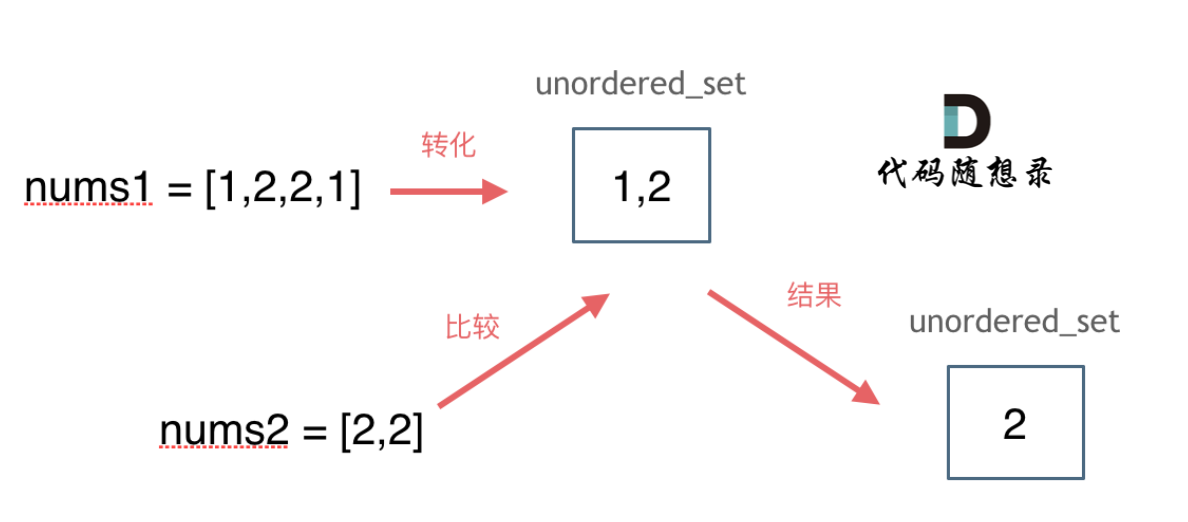- 做项目(多个C++、Java、Go、测开、前端项目) (opens new window)
- 刷算法(两个月高强度学算法) (opens new window)
- 背八股(40天挑战高频面试题) (opens new window)
如果哈希值比较少、特别分散、跨度非常大,使用数组就造成空间的极大浪费!
# 349. 两个数组的交集
题意:给定两个数组,编写一个函数来计算它们的交集。

说明: 输出结果中的每个元素一定是唯一的。 我们可以不考虑输出结果的顺序。
# 算法公开课
《代码随想录》算法视频公开课 (opens new window)::学透哈希表,set使用有技巧!Leetcode:349. 两个数组的交集 (opens new window),相信结合视频再看本篇题解,更有助于大家对本题的理解。
# 思路
这道题目,主要要学会使用一种哈希数据结构:unordered_set,这个数据结构可以解决很多类似的问题。
注意题目特意说明:输出结果中的每个元素一定是唯一的,也就是说输出的结果的去重的, 同时可以不考虑输出结果的顺序
这道题用暴力的解法时间复杂度是O(n^2),那来看看使用哈希法进一步优化。
那么用数组来做哈希表也是不错的选择,例如242. 有效的字母异位词 (opens new window)
但是要注意,使用数组来做哈希的题目,是因为题目都限制了数值的大小。
而这道题目没有限制数值的大小,就无法使用数组来做哈希表了。
而且如果哈希值比较少、特别分散、跨度非常大,使用数组就造成空间的极大浪费。
此时就要使用另一种结构体了,set ,关于set,C++ 给提供了如下三种可用的数据结构:
- std::set
- std::multiset
- std::unordered_set
std::set和std::multiset底层实现都是红黑树,std::unordered_set的底层实现是哈希表, 使用unordered_set 读写效率是最高的,并不需要对数据进行排序,而且还不要让数据重复,所以选择unordered_set。
思路如图所示:

C++代码如下:
class Solution {
public:
vector<int> intersection(vector<int>& nums1, vector<int>& nums2) {
unordered_set<int> result_set; // 存放结果,之所以用set是为了给结果集去重
unordered_set<int> nums_set(nums1.begin(), nums1.end());
for (int num : nums2) {
// 发现nums2的元素 在nums_set里又出现过
if (nums_set.find(num) != nums_set.end()) {
result_set.insert(num);
}
}
return vector<int>(result_set.begin(), result_set.end());
}
};
2
3
4
5
6
7
8
9
10
11
12
13
14
- 时间复杂度: O(n + m) m 是最后要把 set转成vector
- 空间复杂度: O(n)
# 拓展
那有同学可能问了,遇到哈希问题我直接都用set不就得了,用什么数组啊。
直接使用set 不仅占用空间比数组大,而且速度要比数组慢,set把数值映射到key上都要做hash计算的。
不要小瞧 这个耗时,在数据量大的情况,差距是很明显的。
# 后记
本题后面 力扣改了 题目描述 和 后台测试数据,增添了 数值范围:
- 1 <= nums1.length, nums2.length <= 1000
- 0 <= nums1[i], nums2[i] <= 1000
所以就可以 使用数组来做哈希表了, 因为数组都是 1000以内的。
对应C++代码如下:
class Solution {
public:
vector<int> intersection(vector<int>& nums1, vector<int>& nums2) {
unordered_set<int> result_set; // 存放结果,之所以用set是为了给结果集去重
int hash[1005] = {0}; // 默认数值为0
for (int num : nums1) { // nums1中出现的字母在hash数组中做记录
hash[num] = 1;
}
for (int num : nums2) { // nums2中出现话,result记录
if (hash[num] == 1) {
result_set.insert(num);
}
}
return vector<int>(result_set.begin(), result_set.end());
}
};
2
3
4
5
6
7
8
9
10
11
12
13
14
15
16
- 时间复杂度: O(m + n)
- 空间复杂度: O(n)
# 其他语言版本
# Java:
版本一:使用HashSet
// 时间复杂度O(n+m+k) 空间复杂度O(n+k)
// 其中n是数组nums1的长度,m是数组nums2的长度,k是交集元素的个数
import java.util.HashSet;
import java.util.Set;
class Solution {
public int[] intersection(int[] nums1, int[] nums2) {
if (nums1 == null || nums1.length == 0 || nums2 == null || nums2.length == 0) {
return new int[0];
}
Set<Integer> set1 = new HashSet<>();
Set<Integer> resSet = new HashSet<>();
//遍历数组1
for (int i : nums1) {
set1.add(i);
}
//遍历数组2的过程中判断哈希表中是否存在该元素
for (int i : nums2) {
if (set1.contains(i)) {
resSet.add(i);
}
}
//方法1:将结果集合转为数组
return res.stream().mapToInt(Integer::intValue).toArray();
/**
* 将 Set<Integer> 转换为 int[] 数组:
* 1. stream() : Collection 接口的方法,将集合转换为 Stream<Integer>
* 2. mapToInt(Integer::intValue) :
* - 中间操作,将 Stream<Integer> 转换为 IntStream
* - 使用方法引用 Integer::intValue,将 Integer 对象拆箱为 int 基本类型
* 3. toArray() : 终端操作,将 IntStream 转换为 int[] 数组。
*/
//方法2:另外申请一个数组存放setRes中的元素,最后返回数组
int[] arr = new int[resSet.size()];
int j = 0;
for(int i : resSet){
arr[j++] = i;
}
return arr;
}
}
2
3
4
5
6
7
8
9
10
11
12
13
14
15
16
17
18
19
20
21
22
23
24
25
26
27
28
29
30
31
32
33
34
35
36
37
38
39
40
41
42
43
44
45
版本二:使用Hash數組
class Solution {
public int[] intersection(int[] nums1, int[] nums2) {
int[] hash1 = new int[1002];
int[] hash2 = new int[1002];
for(int i : nums1)
hash1[i]++;
for(int i : nums2)
hash2[i]++;
List<Integer> resList = new ArrayList<>();
for(int i = 0; i < 1002; i++)
if(hash1[i] > 0 && hash2[i] > 0)
resList.add(i);
int index = 0;
int res[] = new int[resList.size()];
for(int i : resList)
res[index++] = i;
return res;
}
}
2
3
4
5
6
7
8
9
10
11
12
13
14
15
16
17
18
19
# Python3:
(版本一) 使用字典和集合
class Solution:
def intersection(self, nums1: List[int], nums2: List[int]) -> List[int]:
# 使用哈希表存储一个数组中的所有元素
table = {}
for num in nums1:
table[num] = table.get(num, 0) + 1
# 使用集合存储结果
res = set()
for num in nums2:
if num in table:
res.add(num)
del table[num]
return list(res)
2
3
4
5
6
7
8
9
10
11
12
13
14
15
(版本二) 使用数组
class Solution:
def intersection(self, nums1: List[int], nums2: List[int]) -> List[int]:
count1 = [0]*1001
count2 = [0]*1001
result = []
for i in range(len(nums1)):
count1[nums1[i]]+=1
for j in range(len(nums2)):
count2[nums2[j]]+=1
for k in range(1001):
if count1[k]*count2[k]>0:
result.append(k)
return result
2
3
4
5
6
7
8
9
10
11
12
13
14
15
(版本三) 使用集合
class Solution:
def intersection(self, nums1: List[int], nums2: List[int]) -> List[int]:
return list(set(nums1) & set(nums2))
2
3
4
# Go:
(版本一)使用字典和集合
func intersection(nums1 []int, nums2 []int) []int {
set:=make(map[int]struct{},0) // 用map模拟set
res:=make([]int,0)
for _,v:=range nums1{
if _,ok:=set[v];!ok{
set[v]=struct{}{}
}
}
for _,v:=range nums2{
//如果存在于上一个数组中,则加入结果集,并清空该set值
if _,ok:=set[v];ok{
res=append(res,v)
delete(set, v)
}
}
return res
}
2
3
4
5
6
7
8
9
10
11
12
13
14
15
16
17
(版本二)使用数组
func intersection(nums1 []int, nums2 []int) []int {
count1 := make([]int, 1001, 1001)
count2 := make([]int, 1001, 1001)
res := make([]int, 0)
for _, v := range nums1 {
count1[v] = 1
}
for _, v := range nums2 {
count2[v] = 1
}
for i := 0; i <= 1000; i++ {
if count1[i] + count2[i] == 2 {
res = append(res, i)
}
}
return res
}
2
3
4
5
6
7
8
9
10
11
12
13
14
15
16
17
# JavaScript:
/**
* @param {number[]} nums1
* @param {number[]} nums2
* @return {number[]}
*/
var intersection = function(nums1, nums2) {
// 根据数组大小交换操作的数组
if(nums1.length < nums2.length) {
const _ = nums1;
nums1 = nums2;
nums2 = _;
}
const nums1Set = new Set(nums1);
const resSet = new Set();
// for(const n of nums2) {
// nums1Set.has(n) && resSet.add(n);
// }
// 循环 比 迭代器快
for(let i = nums2.length - 1; i >= 0; i--) {
nums1Set.has(nums2[i]) && resSet.add(nums2[i]);
}
return Array.from(resSet);
};
2
3
4
5
6
7
8
9
10
11
12
13
14
15
16
17
18
19
20
21
22
23
# TypeScript:
版本一(正常解法):
function intersection(nums1: number[], nums2: number[]): number[] {
let resSet: Set<number> = new Set(),
nums1Set: Set<number> = new Set(nums1);
for (let i of nums2) {
if (nums1Set.has(i)) {
resSet.add(i);
}
}
return Array.from(resSet);
};
2
3
4
5
6
7
8
9
10
版本二(秀操作):
function intersection(nums1: number[], nums2: number[]): number[] {
return Array.from(new Set(nums1.filter(i => nums2.includes(i))))
};
2
3
# Swift:
func intersection(_ nums1: [Int], _ nums2: [Int]) -> [Int] {
var set1 = Set<Int>()
var set2 = Set<Int>()
for num in nums1 {
set1.insert(num)
}
for num in nums2 {
if set1.contains(num) {
set2.insert(num)
}
}
return Array(set2)
}
2
3
4
5
6
7
8
9
10
11
12
13
# PHP:
class Solution {
/**
* @param Integer[] $nums1
* @param Integer[] $nums2
* @return Integer[]
*/
function intersection($nums1, $nums2) {
if (count($nums1) == 0 || count($nums2) == 0) {
return [];
}
$counts = [];
$res = [];
foreach ($nums1 as $num) {
$counts[$num] = 1;
}
foreach ($nums2 as $num) {
if (isset($counts[$num])) {
$res[] = $num;
}
unset($counts[$num]);
}
return $res;
}
}
2
3
4
5
6
7
8
9
10
11
12
13
14
15
16
17
18
19
20
21
22
23
24
25
# Rust:
use std::collections::HashSet;
impl Solution {
pub fn intersection(nums1: Vec<i32>, nums2: Vec<i32>) -> Vec<i32> {
let mut resultSet: HashSet<i32> = HashSet::with_capacity(1000);
let nums1Set: HashSet<i32> = nums1.into_iter().collect();
for num in nums2.iter() {
if nums1Set.contains(num) {
resultSet.insert(*num);
}
}
let ret: Vec<i32> = resultSet.into_iter().collect();
ret
}
}
2
3
4
5
6
7
8
9
10
11
12
13
14
15
16
解法2:
use std::collections::HashSet;
impl Solution {
pub fn intersection(nums1: Vec<i32>, nums2: Vec<i32>) -> Vec<i32> {
nums1
.into_iter()
.collect::<HashSet<_>>()
.intersection(&nums2.into_iter().collect::<HashSet<_>>())
.copied()
.collect()
}
}
2
3
4
5
6
7
8
9
10
11
# C:
int* intersection1(int* nums1, int nums1Size, int* nums2, int nums2Size, int* returnSize){
int nums1Cnt[1000] = {0};
int lessSize = nums1Size < nums2Size ? nums1Size : nums2Size;
int * result = (int *) calloc(lessSize, sizeof(int));
int resultIndex = 0;
int* tempNums;
int i;
/* Calculate the number's counts for nums1 array */
for(i = 0; i < nums1Size; i ++) {
nums1Cnt[nums1[i]]++;
}
/* Check if the value in nums2 is existing in nums1 count array */
for(i = 0; i < nums2Size; i ++) {
if(nums1Cnt[nums2[i]] > 0) {
result[resultIndex] = nums2[i];
resultIndex ++;
/* Clear this count to avoid duplicated value */
nums1Cnt[nums2[i]] = 0;
}
}
* returnSize = resultIndex;
return result;
}
2
3
4
5
6
7
8
9
10
11
12
13
14
15
16
17
18
19
20
21
22
23
24
25
26
27
# Scala:
正常解法:
object Solution {
def intersection(nums1: Array[Int], nums2: Array[Int]): Array[Int] = {
// 导入mutable
import scala.collection.mutable
// 临时Set,用于记录数组1出现的每个元素
val tmpSet: mutable.HashSet[Int] = new mutable.HashSet[Int]()
// 结果Set,存储最终结果
val resSet: mutable.HashSet[Int] = new mutable.HashSet[Int]()
// 遍历nums1,把每个元素添加到tmpSet
nums1.foreach(tmpSet.add(_))
// 遍历nums2,如果在tmpSet存在就添加到resSet
nums2.foreach(elem => {
if (tmpSet.contains(elem)) {
resSet.add(elem)
}
})
// 将结果转换为Array返回,return可以省略
resSet.toArray
}
}
2
3
4
5
6
7
8
9
10
11
12
13
14
15
16
17
18
19
20
骚操作1:
object Solution {
def intersection(nums1: Array[Int], nums2: Array[Int]): Array[Int] = {
// 先转为Set,然后取交集,最后转换为Array
(nums1.toSet).intersect(nums2.toSet).toArray
}
}
2
3
4
5
6
骚操作2:
object Solution {
def intersection(nums1: Array[Int], nums2: Array[Int]): Array[Int] = {
// distinct去重,然后取交集
(nums1.distinct).intersect(nums2.distinct)
}
}
2
3
4
5
6
7
# C#:
public int[] Intersection(int[] nums1, int[] nums2) {
if(nums1==null||nums1.Length==0||nums2==null||nums1.Length==0)
return new int[0]; //注意数组条件
HashSet<int> one = Insert(nums1);
HashSet<int> two = Insert(nums2);
one.IntersectWith(two);
return one.ToArray();
}
public HashSet<int> Insert(int[] nums){
HashSet<int> one = new HashSet<int>();
foreach(int num in nums){
one.Add(num);
}
return one;
}
2
3
4
5
6
7
8
9
10
11
12
13
14
15
16
# Ruby:
def intersection(nums1, nums2)
hash = {}
result = {}
nums1.each do |num|
hash[num] = 1 if hash[num].nil?
end
nums2.each do |num|
#取nums1和nums2交集
result[num] = 1 if hash[num] != nil
end
return result.keys
end
2
3
4
5
6
7
8
9
10
11
12
13
14
15
# 相关题目
← 2. 有效的字母异位词 4. 快乐数 →
